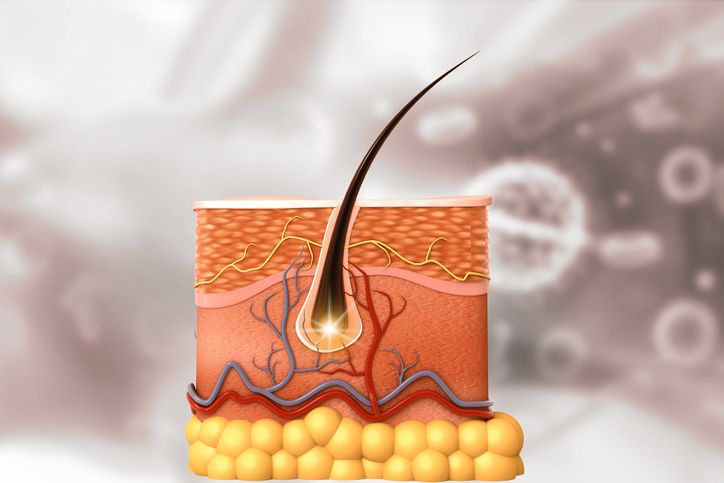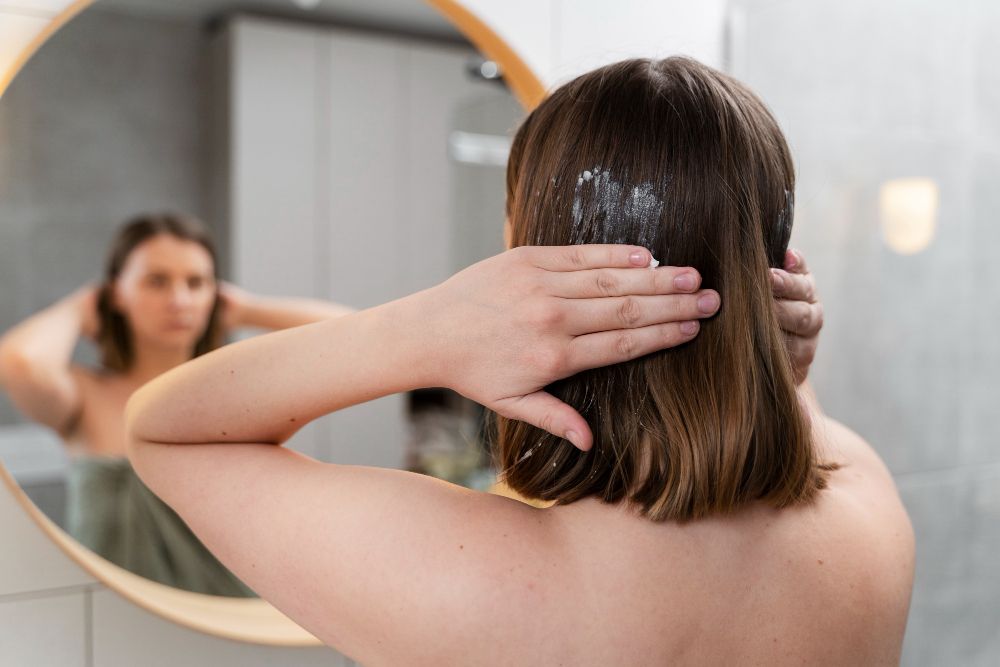- Home
- Trend
- Weight Loss Strategies
- Acne Tips
- Hair Health Information
- Blemish Removal Tips
- Acne Scar Removal Tips
- Muscle Building Techniques
- Intimate Care Tips
- Postpartum Intimate Care
- Eye Bags Wiki
- Tips for Face Slimming
- Secret of Permanent Hair Removal
- Breast Enlargement Tips
- Cure to Snoring
- Marionette Lines
- Skin-Tightening Secrets
Hair follicle atrophy is a problem that no one wants to experience. As time passes, it leads to hair loss and thinning, affecting both appearance and confidence. As we age, we begin to notice changes in our hair when we look in the mirror, leading to the question: “Why is my hair falling out?” Every hair follicle is a living organism, and the causes behind its shrinkage are numerous and complex. This article will not only discuss the reasons for hair follicle atrophy but also share its effects, treatments, and prevention methods, helping you take preventive measures early.
What is a Hair Follicle?

The hair follicle is the place where hair grows. It supplies nutrients to the hair, promoting hair growth. The condition and appearance of the hair are closely linked to the health of the hair follicle. Once the follicle shrinks, the hair will be affected as well.
What is Hair Follicle Atrophy?

During the hair growth cycle, there is a regressive phase that lasts for a short period—around 2 to 3 weeks. During this time, the hair bulb inside the follicle shrinks, and the cell division rate slows down until it stops, causing hair growth to cease. However, this is a transitional phase from growth to shedding and is part of the normal hair metabolism process. In some individuals, due to genetic or other factors, the hair follicle may shrink and experience functional disorders. The hair that grows afterward may become fragile, finer, and softer, with a shorter growth cycle or may not grow at all, leading to thinning hair or even baldness.
免費體驗
F8 Hair Regrowth Treatment
1 Minute Self-Registration
Date should not be before minimal date
Hair Follicle Atrophy = Hair Loss?
Actually, hair loss, hair follicle atrophy, and hair follicle closure are different.
• Hair Loss: On average, people shed 50-150 hairs a day, which is part of the normal hair metabolism process. After hair loss, the hair follicle will enter the growth phase again, and new hair will grow. Before shedding, the follicle will slightly shrink as it actively cuts the connection between the hair and the follicle.
• Hair Follicle Atrophy: While this is a normal phenomenon, severe hair follicle atrophy is a functional disorder of the hair, leading to widespread hair loss. Daily shedding exceeds 150 hairs, and the new hair that grows becomes softer, thinner, or fewer in number. If hair follicle atrophy occurs, it should be addressed early. With changes in lifestyle, sleep patterns, diet, and exercise, there is a chance for reversal. It may take 1-2 years, or even 5-10 years, for hair follicle atrophy to progress to closure, so vigilance is needed.
• Hair Follicle Closure: This means the hair follicle has died and will no longer produce new hair. When inspecting the scalp closely, the bald areas will show no visible pores, indicating that the follicles have closed and can no longer function as they once did. Hair follicle closure is irreversible, and the only solution is hair transplantation, where healthy follicles are moved to bald areas.
The Effects of Hair Follicle Atrophy You Can’t Ignore
1. Scalp Hair Follicle Atrophy leads to a progressively thinning hairline and ultimately baldness.
2. Baldness affects personal image and confidence, especially for those sensitive about their appearance. They may feel older than they actually are, as external judgments trigger self-doubt, leading to anxiety and psychological pressure. Under stress, follicles are more susceptible to hormonal stimulation, worsening the hair loss problem in a vicious cycle.
3. For those whose careers heavily rely on their external appearance, such as models and PR professionals, baldness may affect their professional development and limit their future prospects.
4. Due to hair loss, individuals may spend more time, money, and energy searching for suitable treatments, such as medications, products, and ultimately hair transplant surgeries, all of which come with pain.
5. In social situations, people might feel the need to cover thinning areas, leading to discomfort and impacting their social life. Hair loss diminishes life quality, affecting personal satisfaction with appearance and potentially causing them to wonder if their diet is to blame for the hair loss, leading them to miss out on many aspects of life.
The 6 Major Causes of Hair Follicle Atrophy
• Cause 1: Genetics
Genetic hair loss, including male pattern baldness, occurs because immune functions in the chromosomes attack the scalp follicles due to hormonal reactions. Dihydrotestosterone (DHT) leads to male baldness, with men being more affected than women. Hair follicles on other body parts are not impacted, but those on the scalp are attacked, causing hair to become thinner, softer, and shorter, with a shorter growth cycle.
• Cause 2: High Stress
Stress-induced hair loss is caused by prolonged mental and physical stress that isn’t alleviated. This leads to dysfunction in the hair follicle’s basic functions, such as the slow absorption of nutrients by the dermal papilla, preventing it from giving proper instructions for cell division. Hair growth slows down, and the growth cycle shortens, causing even healthy follicles to shrink. Hair in this condition becomes fragile, and hair volume decreases.
• Cause 3: Aging
As we age, hair follicles also undergo aging, with reduced functionality and slower nutrient absorption, accelerating the shrinkage process. Thinning hair in older adults is a natural sign of aging, but nowadays, many young people experience premature follicle aging due to poor lifestyles, and this situation needs attention.
• Cause 4: Hormonal Fluctuations
While the increase in male hormones leads to male pattern baldness, fluctuations in female hormones can also cause women to experience male pattern baldness. In particular, postpartum women may experience increased hair loss within two to three months, and women going through menopause may face hair follicle atrophy and hair loss issues due to decreased estrogen levels.
• Cause 5: Poor Lifestyle and Nutrient Deficiency
Unhealthy habits such as excessive alcohol consumption, smoking, frequent late nights, exposure to pollution, and poor diet can deprive hair follicles of essential nutrients like vitamins, minerals, and proteins, leading to premature aging and shrinkage of the follicles.
• Cause 6: Illness
Certain diseases and medications can cause hair follicle atrophy, including autoimmune diseases, thyroid problems, chronic illnesses, and scalp sensitivity or inflammation. Conditions such as pustular psoriasis or scalp infections can damage hair follicles by reducing blood circulation to the scalp and depriving the follicles of nutrients, causing them to shrink.
免費體驗
F8 Hair Regrowth Treatment
1 Minute Self-Registration
Date should not be before minimal date
Are There Any Signs of Follicular Atrophy?
Sign 1: Shortened Hair Growth Cycle
Typically, the hair growth phase lasts 2-6 years before entering a brief regression phase, followed by a resting phase where the hair falls out and a new hair begins to grow. However, follicular atrophy leads to a shortened growth phase, prematurely entering the resting phase. The vitality of the follicles weakens, resulting in faster hair loss but slower regrowth of new hair.
Sign 2: Deterioration of Hair Quality and Increased Hair Loss
An early sign of follicular atrophy is hair thinning, breakage, and increased shedding. The hairline begins to recede, and the parting on the scalp may widen, making the hair appear sparser. You may notice an increase in hair loss when combing or washing your hair, and hair can become tangled, split, frizzy, and lose its shine. Some people also notice localized bald patches, which become more obvious over time. A simple test can be performed by gently tugging a handful of hair. If more than 15-20 strands fall out, it could indicate abnormal hair loss.
Sign 3: Increased Likelihood of Scalp Sensitivity or Inflammation
When follicular health declines, scalp discomfort can occur, such as reduced function of sebaceous and sweat glands, leading to dryness, itching, dandruff, or even excessive oiliness. Some people may also experience scalp inflammation, such as redness, swelling, and pustules. These issues can further affect follicle health and hair growth, resulting in poor hair quality and difficulty in regrowing hair. Maintaining scalp oil and moisture balance can help reduce these issues.
Treatment Options for Follicular Atrophy
If Follicles Are Not Completely Dead or Closed:
Follicular atrophy requires active treatment. After assessing the extent of hair loss, proper treatment can be administered by a professional doctor. Medications like minoxidil and finasteride can control male hormones and DHT, preventing them from attacking healthy hair follicles. If there are issues like inflammation or scalp redness, light therapy can help improve scalp conditions and promote healthy hair growth. Medication should be obtained through professionals, not from illegal sources or self-prescribed.
If Follicles Are Dead and Closed:
In cases where follicles are dead, hair transplant surgery is an option. Healthy follicles are extracted and transplanted to bald areas to encourage regrowth. However, surgery is more expensive than medications and hair growth solutions, and comes with some risks, such as pain and scarring. New hair growth may not be perfectly healthy, and as age progresses, follicles may deteriorate again, requiring more surgeries. If surgery is not considered, wigs or hairpieces can be used to cover bald spots.
Prevention of Follicular Atrophy
1. Maintain a Healthy Scalp
A healthy scalp supports hair growth, so keeping the scalp clean is important. Regularly remove dead skin and excess scalp dirt, oil, and pollutants. Improve blood circulation to the scalp to deliver nutrients to each follicle, promoting healthy hair growth while reducing inflammation and dandruff.
2. Use Hair and Scalp Care Products
After using shampoo, make sure to moisturize both your hair and scalp to maintain balance between oil and moisture. This helps prevent scalp oiliness or dryness, ensures the normal growth cycle of hair, and shields it from external stimuli. Look for gentle, natural products that do not irritate the scalp or dry out hair.
3. Lifestyle Changes
Making changes that are beneficial for your hair can help slow down the atrophy of follicles. Regularly trim damaged hair ends, avoid over-dyeing or curling hair, consume foods beneficial for hair health, exercise to improve circulation, reduce stress, and ensure adequate sleep—all help in slowing down follicular atrophy and controlling hair loss.
4. Scalp Massage
Scalp massage has many benefits, such as improving follicular metabolism and blood circulation, reducing follicular aging, providing more nutrients and oxygen to the scalp, and increasing scalp resistance. These benefits can stimulate healthy hair growth and reduce hair loss. It’s recommended to massage the scalp 1-2 times a week with your fingertips (avoiding nails), using natural plant-based oils along the scalp lines, including the forehead, top of the head, back of the head, and sides.
免費體驗
F8 Hair Regrowth Treatment
1 Minute Self-Registration
Date should not be before minimal date
Are You Noticing the Signs of Follicular Atrophy? — Experience the Perfect Medical F8 Hair Regrowth Treatment Today!
Follicular atrophy is a natural aging process that many people wish to avoid, but it’s inevitable. Addressing the issue before follicular closure occurs is the best solution. The Perfect Medical F8 Hair Regrowth Treatment uses soft laser technology to enhance scalp blood circulation, creating an environment conducive to hair growth and revitalizing dormant follicles, promoting healthy hair growth.
If you've noticed a decline in your hair quality, dullness, frizziness, and thinning, don't wait—experience the F8 Hair Regrowth Treatment today! With medical-grade hair restoration essence, it nourishes follicle cells and improves hair nutrition. The treatment is comfortable, safe, painless, and non-invasive, with no side effects. It also helps relieve stress, which can otherwise exacerbate follicular atrophy. Register today to enjoy a free treatment session!
Register Now: Perfect Medical F8 Hair Regrowth Treatment免費體驗
F8 Hair Regrowth Treatment
1 Minute Self-Registration
Date should not be before minimal date
FAQ

How can I tell if my follicles are atrophying?
Follicle testing can reveal this. Using modern technology, up to 200x magnification allows us to clearly observe follicular condition. We can also detect which areas are experiencing hair loss and prevent further shedding. Additionally, follicle testing can identify scalp inflammation, oil levels, and thinning hair. If the follicles are no longer capable of producing hair, they are considered dead, and a professional magnified test will provide accurate information, allowing for timely and appropriate responses.
Can follicular atrophy be reversed?
For areas where hair density is sparse but hair is still growing, the follicles are still viable. You can take steps to maintain follicular vitality, such as improving blood circulation and supplementing nutrition, using nutrient sprays, and taking blood-activating herbs and vitamins to encourage healthy hair regrowth. However, if the bald area is smooth with very fine, soft hair growth and no visible pores, the follicles have fully atrophied. At this point, no intervention will help, and hair transplant surgery is required for improvement.
What causes hair thinning?
In addition to follicular atrophy, common causes include hereditary hair loss (male pattern baldness) and external factors like stress, late nights, and poor nutrition. If you notice hair thinning, consider whether you have habits like late nights, unhealthy eating, and stress, and address them with professional help (medications and hair growth solutions).
Can laser therapy improve follicular atrophy?
If the follicles have not yet reached a point of total atrophy, laser therapy can be highly effective. Soft laser technology increases blood circulation, activates dormant follicles, and promotes hair growth. We recommend trying the Perfect Medical F8 Hair Regrowth Treatment, which includes soft laser technology along with medical-grade hair restoration essence, providing essential nutrients to support healthy hair growth. It's definitely worth the investment.
How can I self-test if hair loss is normal or abnormal?
To self-test, check the roots of fallen hair. Normally, the root will have a small white bulb, which is oil and sebum, indicating that the hair has completed its growth cycle. However, if the hair falls out without a root and with unnatural curls, it may indicate abnormal hair loss. If it's just one or two hairs, it could be due to tight hairstyles or rough combing. But if many hairs fall out without roots and are short and thin, it’s a sign of follicular atrophy.









